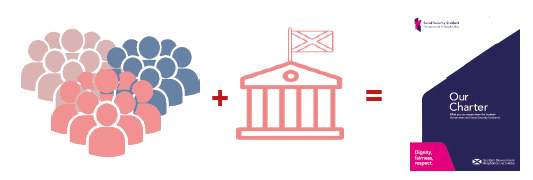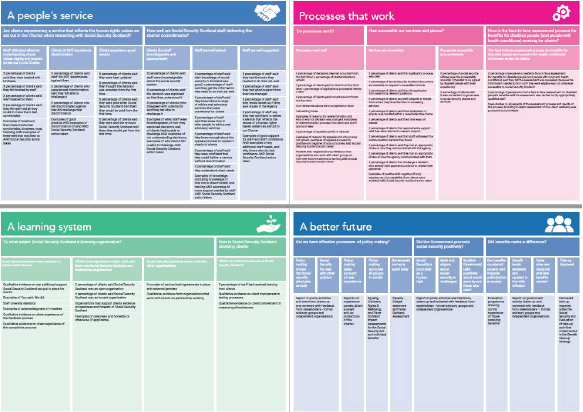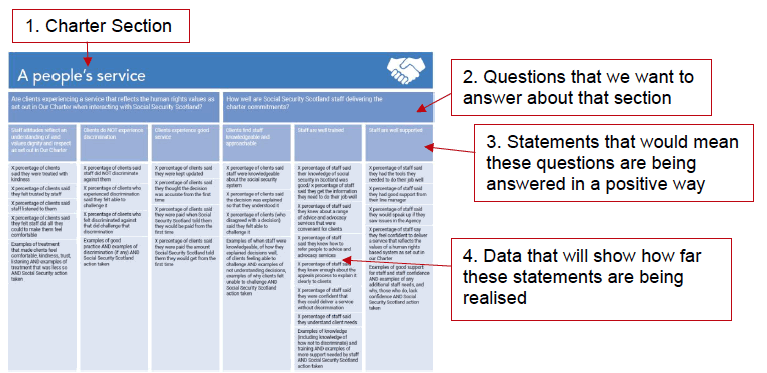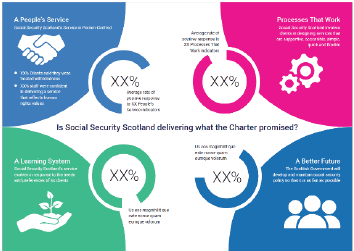Social Security Charter measurement framework: visual summary of the co-design process
A short summary report, using images, to show how the social security Charter Measurement Framework was co-designed with people with lived experience of the social security system.
Developing a Measurement Framework for the Social Security Charter in Scotland: Analytical co-design in action - Visual Summary
Background
The Scottish Government is getting new powers to deliver some social security benefits which are currently delivered by the Department for Work and Pensions (DWP). These benefits are gradually being rolled out and delivered by Social Security Scotland.
Department for Work and Pensions → Scottish Government
A Charter, called Our Charter, was made to let people know what to expect from the new system, and was written by people with experience of the UK social security system, and Scottish Government staff.

The Charter is made of 'commitments' which set-out how the new system will work and how clients should be treated. The commitments in Our Charter are split between 4 sections:
- A people's service
- Processes that work
- A learning system
- A better future
To make sure that the commitments in the Charter are being kept. The Scottish Government decided to make a Measurement Framework which will collect information to show how well the new social security system is working
Like the Charter, people with direct experience of the social security system were involved in designing and writing the framework. This group was called Core Group 2.
Core group 2 worked on finding ways to measure the commitments in the first 3 sections of the Charter, which are to do with how well Social Security Scotland's processes are working, and the treatment of clients. The 4th section is about long-term policy aims of the Scottish Government and will be measured in a slightly different way.

Work took place over 6 months
March 2019 → August 2019
Who was involved?
The Scottish Government worked with lots of different people to make the Measurement Framework:
7 Workshops with 20 Core Group 2 Members
Core Group 2 was mainly made up of people from the Social Security Experience Panels. The panels are 2,400 volunteers who have experience of the benefits coming to Scotland. Core group 2 included disabled people with experience of:
- Mental illness
- Physical conditions
- Learning conditions
- Sensory conditions
Core Group 2 included people from lots of different backgrounds with different life experiences, including:
- LGBTI+ people
- Young carers
- Parents & Single parents
- Minority Ethnic people
- People from islands
- Veterans
- BSL users
- Different faith groups
The Group was split fairly evenly by gender
- 55% Male
- 45% Female
2 Meetings with Stakeholders – Professionals who work with, and on behalf of, social security clients
Stakeholder groups that were involved included disability organisations and charities.
2 meetings with The Scottish Commission on Social Security (SCoSS)
The Commission has been set up to look at how well the new Scottish social security system is working; part of the commission's brief is to report on the extent to which the commitments in Our Charter are being met.
Stakeholders and SCoSS provided feedback, advice and ideas for Core Group 2 to consider
How was the framework designed?
To help decide how the framework would measure the commitments in the Charter, Core Group 2 worked with Scottish Government staff to:
- Learn about different ways of measuring things and the kinds of questions they can help to answer
- Look for ways to keep the framework easy to use; for example, by finding ways to put some commitments together so that the framework is not too long.
- Think about the best words to use to make sure we are measuring what is most important to people
- Think about how to make the framework look good and easy to understand
Stakeholders and SCoSS told researchers where they thought things might be missing, or where we could use different words
What is in the framework?
The framework is arranged by the 4 different sections of Our Charter. Each page contains measures that will be able to tell us whether the commitments in that section are being fulfilled.

The page for each section is set out over 4 levels that show how the measures are related to each section of the Charter.

Some of the sections in the framework have more measures than others:
- A people's service: 29
- Processes that work: 26
- A learning system: 15
- A better future: 7
= 77 Measures overall
There will be a summary page at the beginning of the Measurement Framework which will give an overview of how well Social Security Scotland is doing in each section.

Where will we get the data?
The information needed to fill the Measurement Framework will be collected in a number of different ways:
- Surveys, interviews and focus groups with Social Security Scotland clients and staff
- Case studies on certain processes (for example, assessments)
- Statistics and information collected by Social Security Scotland
What are the next steps?
Ways of getting the data needed for the framework will be developed over the next 12 months.
The Charter Measurement Framework will be published every year and will include more data as more benefits are rolled-out.
All of the benefits to be delivered by Social Security Scotland will be rolled-out by 2022/23. By this time, the Charter Measurement Framework will be in full use.
Just like 'Our Charter', the Charter Measurement Framework will be reviewed and might be changed over time.
Contact
Email: julie.guy@gov.scot
There is a problem
Thanks for your feedback